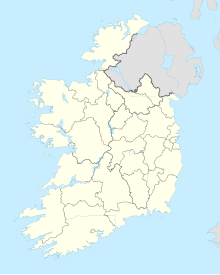Fourknocks
Coordinates: 53 ° 35 '50.6 " N , 6 ° 20' 13.9" W.
Fourknocks ( Irish Na Fuarchnoic , dt. "The cold hills") is a townland in County Meath in Ireland near the village of Naul , but across the Delvin River, which forms the border with County Fingal (formerly part of County Dublin ) . It is known for the Fourknocks I-III megalithic systems located there .
Fourknocks I
The passage Tomb Fourknocks I ( Tuama Pasáiste na bhFuarchnoc ) forms with a group of other facilities ( Knockmany , Knockroe , Knowth , Loughcrew and Newgrange ) a type of monument with various petroglyphs .
investment
Fourknocks was excavated by PJ Hartnett in 1950/52. A coat of clay enclosed the complex. It contained box and pit burials, which also indicate its use as a cillin . Four of the boxes contained the huddled burials of children. One box was empty. The grave goods consisted of a vessel. A pit burial contained another vessel. Two of the boxes contained cremated urns .
Fourknocks differs from other Irish passage tombs by the enormous size of its chamber. The roof of the approximately oval chamber measuring 6 × 7 m was probably made of wood and was supported by a central post, the traces of which were found. Today a steel hood has been pulled over the facility.
The chamber has three evenly distributed side niches, the upper curbs of which have incised decorations (mostly zigzag lines). Other carvings were on the orthostats the Ganges found. One shows a kind of clown face. The face, engraved with simple lines, is the clearest representation of a human face in prehistoric Irish art .
Traces of over 60 burials were found in the corridor and the side niches, but not in the chamber itself. The monument was built between 3000 and 2500 BC. Built in BC.
The visitor to the Fourknocks I facility must be given the key. Openings let in enough light to create a suitable atmosphere.
- Passage Tomb Fourknocks
Fourknocks II
The hill of Fourknocks II lies 135 m east of the passage grave. The hill was excavated. No chamber was found, but a number of cremations were found . Fourknocks II is an unusual structure consisting of a round cairn with a concentric moat and a pit with a megalithic passage on one side. Both complexes are surrounded by an outer ring moat, which is only interrupted in the area of the Ganges. The complex is compared to Millin Bay or Townleyhall , structures that also cannot be properly classified in the scheme of Irish megalithic tombs.
Fourknocks III
The excavation of this two meter high hill with a diameter of 15 m yielded a cremation grave and ceramic finds of the Carrowkeel type. A mug with a piece of seashell should be highlighted.
Micknanstown
Micknanstown near Naul is an unexplored hill that may contain a passage tomb of the Fourknocks group. The hill is about 22.5 m in diameter and 3.9 m high. It is south of a ruined, once very impressive hill.
See also
literature
- Gabriel Cooney: Space, Place and People: unfolding the role of Irish megalithic tombs pp. 331–345 In: KW Beinhauer (Ed.) Studies on Megalithics 1999 ISBN 3-930036-36-3
- Patrick J. Hartnett: Excavation of a Passage Grave at Fourknocks, County Meath . Proceedings of the Royal Irish Academy 58. Section C. No. 5.
- Elizabeth Shee Twohig: Irish Megalithic tombs Princes Risborough Buckinghamshire 1990 ISBN 0-7478-0094-4
Web links
- Description and pictures (English)
- [1] Pictures from Fourknocks I – III)









